Lecture 4 - neurons and action potentials
1/31
Earn XP
Description and Tags
structure & communication: action potential, neurotransmitters, and synapses
Name | Mastery | Learn | Test | Matching | Spaced |
|---|
No study sessions yet.
32 Terms

what are the features of a neuron?
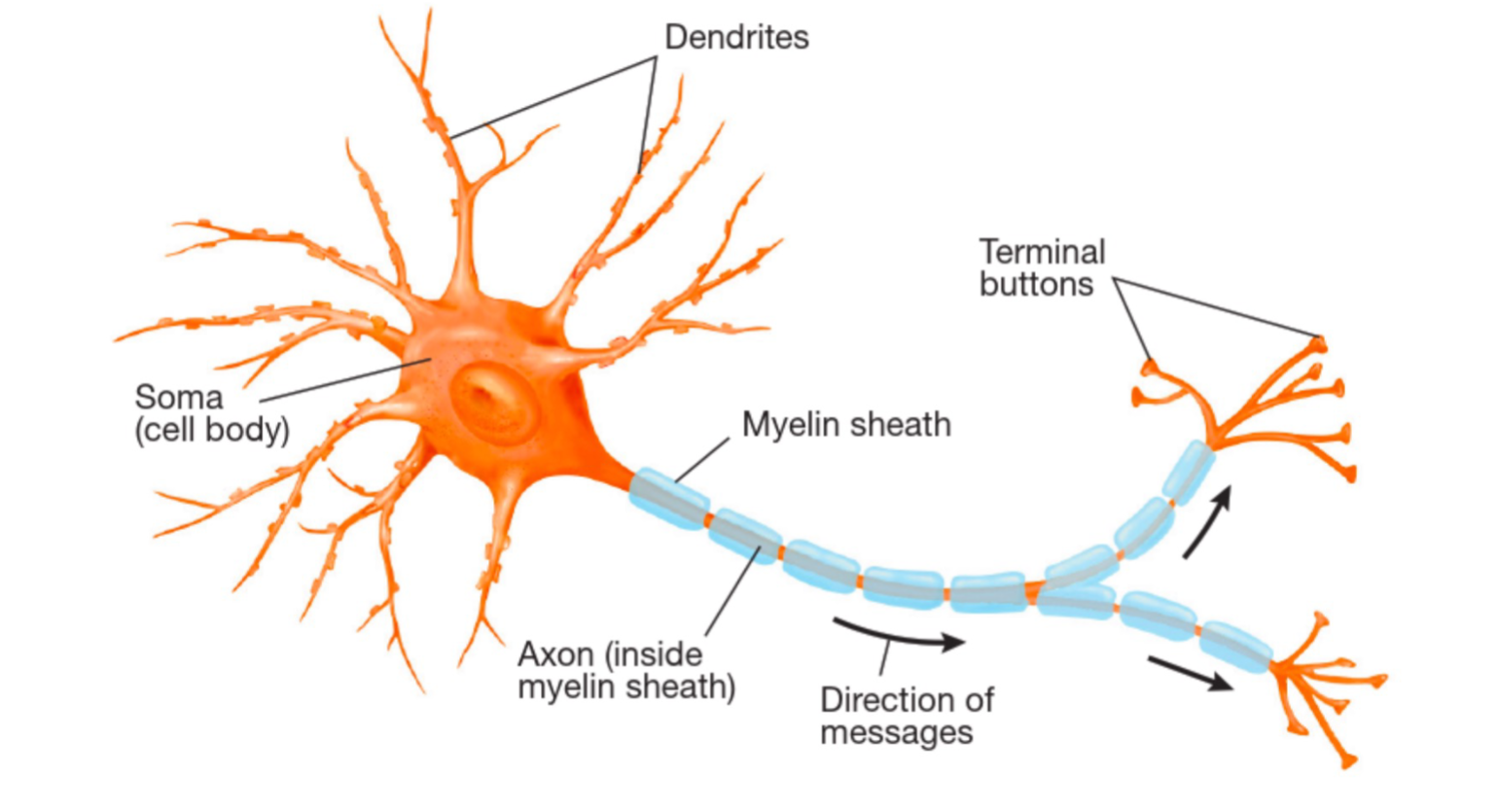
which direction/s does action potential flow?
From dendrites to the cell body (where it originates) towards the terminal buttons
How do action potentials form?
Through the difference in charge inside and outside a neuron cell
where does action potential originate
the soma
what ions are involved in stimulating action potential and where are they?
Na+ and Cl- ions in extracellular fluid
K+ ions in cytoplasm
(predominantly)
What is action potential triggered by?
Rapid change in membrane potential (charge difference) caused by changes in flow of ions (charged molecules) across neuron cell membrane
sodium rushing in and potassium leaving
What is the resting potential?
about -70mV membrane potential
polarised (difference in charge)
extracellular fluid is more positively charged than cytoplasm/ intracellular fluid
What happens to trigger action potential in terms of ion movement / change in membrane potential?
sodium ion channels opened and Na+ flows into the cell → depolarises (less charge difference moving from -70 to 0)
if membrane potential reaches threshold of about -50mV action potential is triggered (cannot stop once met)
what happens as action potential is triggered/ after?
once reaching -50mV this causes potassium ion channels to open, allowing K+ ions to leave neuron
Na+ still continuing to enter so initally memberne potential continues to depolarise
after aprox 1millisecond from an begining of process, action potential reaches its peak and membrane potential is more positive → +40mV. Sodium channels become refractory (close)
no more Na+ can enter until resting potential restored
K+ ions continue to exit → membrane potential returns to resting potential
once membrane potential returns to resting of -70mV, K channels close and Na+ channels reset so that another action depolarisation can cause them to open
as K+ channels close membrane potential becomes hyperpolarized (even more negative than resting) → for subsequent triggering of action potentials a greater influx of Na+ immediately after will be required to until resting potential stabilises
what is the benefit of the refractory period of sodium channels?
ensures that process will keep pushing forward and not be disrupted
what is the benefit of hyperpolarzisation
neurons won’t endlessly fire action potential
Where do ions flow across the neuron membrance?
in the gaps between the myelin → causes action potential to move faster
action potential
known as decremental conduction/ saltatory conduction → action potential triggered from node to node (in between myelin) to pass on electrical condction.
advantage of this:
as can only enter at “nodes" of Raniver” less Na+ can enter thus less must be pumped out to reset for resting potential
greater speed as myelinated
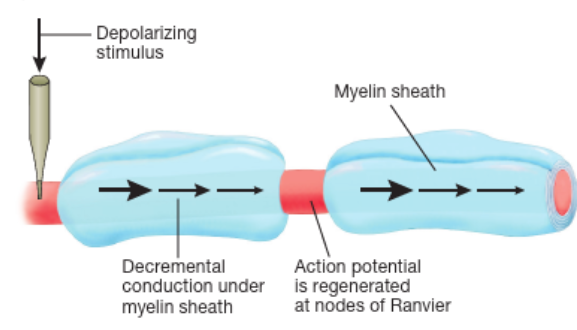
advantage of ion flow only in gaps between myelin
as can only enter at “nodes" of Raniver” less Na+ can enter thus less must be pumped out to reset for resting potential
greater speed as myelinated
rate law of action potentials
neuron firing is all or none
stregnth of neural signal is determined by frequency of firing:
strong stimulus = faster threshold for activation (neurotransmitters) = more frequent action potentials = stronger neural signal
action potential always remains of same size → if axon splits then action potential will split but again does not diminish in size
how do Na+ and K+ ions move?
They diffuse down the concentration gradient
Why do Cl- ions not move in action potential process (typically)?
While concentration gradient force pushes it into the cell, the intracellular environment is negative thus Cl- is repelled by electrosatic force
forces negate each other
sodium potassium pump
maintains this resting potential/ concentration gradient

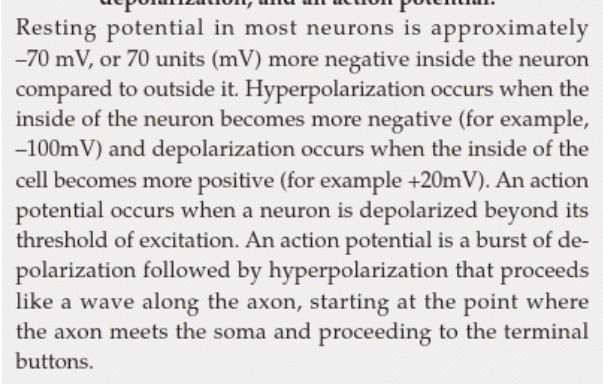

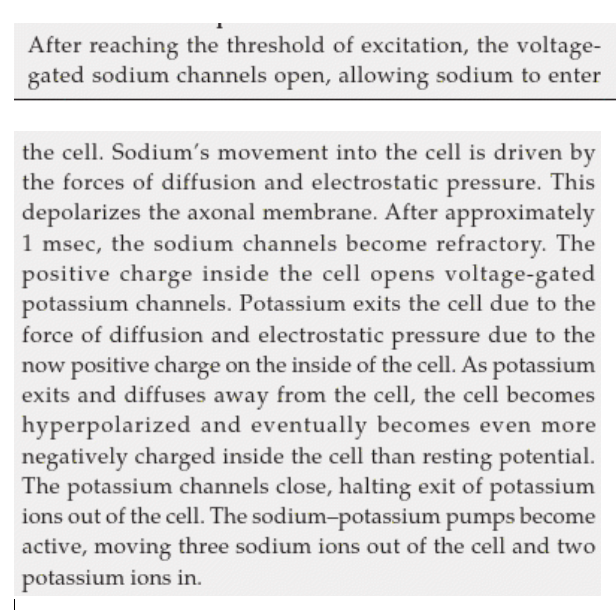


structure of synapse
terminal button (of pre-synaptic neuron)
synaptic cleft (gap between two neurons)
pre and post synaptic membrane (where neurotransmitters exit and are recieved)
synaptic vesicles (package + exocytose neurotransmitters)
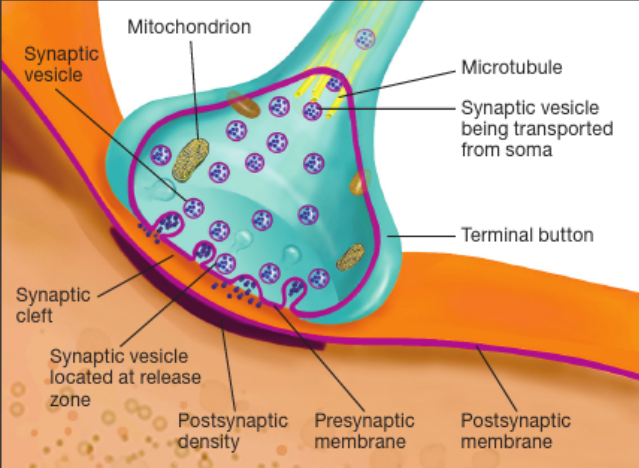
What are neurotransmitters
chemicals that are synthesises within the brain/neurons → chemical messages
influence the post-synaptic neuron and likelihood of action potential firing
What is process of releasing neurotransmitter
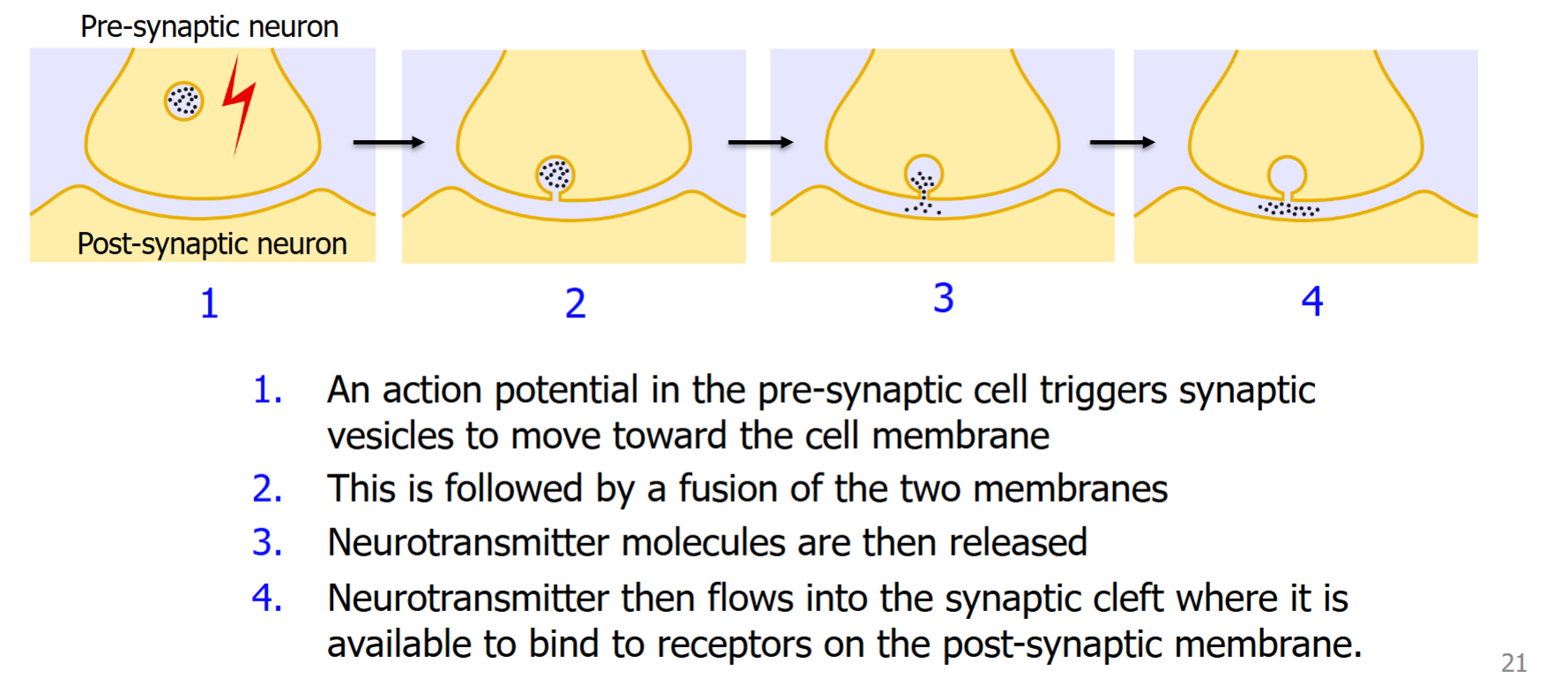
What is neurotransmitter release?
synaptic vesicle merges with presynaptic membrane and contents released to synaptic cleft
(looks like exocytosis)
What is neurotransmitter reuptake?
synapse can recycle and reuse neurotransmitter once released
reabsorbtion to terminal button via endocytosis

what are excitatory postsynaptic potentials (EPSP)?
depolarise postsynaptic cell membrane
increase likelihood that action potential will be triggered in postsynaptic neuron
glutamate is primary excitatory neurotransmitter
neuron will only fire if sum of exitatory input is sufficiently greater than inhibitory input → membrane potential passes threshold
what are inhibitory postsynaptic potentials (IPSP)?
neural inhibition
GABA is primary IPSP/ inhibitory neurotransmitter
decreased likelihood that action potential will be triggered
hyperpolarise the postsynaptic cell membrane
What is neural integration?
combined effect of EPSPs and IPSPs
EPSP and IPSP impact flow of ions into neuron
net effect → action potential triggered/ not triggered
more excitatory than inhibitory → excitation
multiple neurons sending neurotransmitters to a given postsynpatic neuron
each neuron can only either release ESPS or IPSPs
if lots of excitatory → would reach threshold faster → greater strength of neural signal
common neuromodulators functions and difference with neurotransmitters
dopamine → motivation, learning
noradrenaline → flight/fight
histamine
seratonin → sleep, mood
modulators→ global function released and produced all over the brain
transmitters → more localised effects restricted to specific pathways or locations
How do neurotransmitters effect post-synpatic neuron?
neurotransmitter binds to a receptor sensitive to that neurotransmitter
receptor will then trigger an event leading to either excitation/ inhibition e..g opening of ion channel
receptors are highly selective (will only bind to one structure // one neurotransmitter or drug that mimics it)
neurotransmitter may activate multiple receptors, but each receptor can only be activated by one
often medications that mimic neurotransmitter can only bind to one receptor (as they do not have same properties as neutroansmitter entirely)
How do drugs work for neurotransmitters?
mimic natural neurotransmitters / neuromodulators (shape - bind to receptors)
agonists → activating receptor like natural compound
antagonists → blocking receptor or preventing natural compound from activating it (like enzyme inhibitors)
lots of steps in neuron process means lots of places where drugs can impact each step (synthesis of neurotransmitters themselves, binding of neurotransmitters to receptor, release of neurotransmitters, etc.)
drugs can ONLY impact as they mimic a natural compound → if no receptor no effect